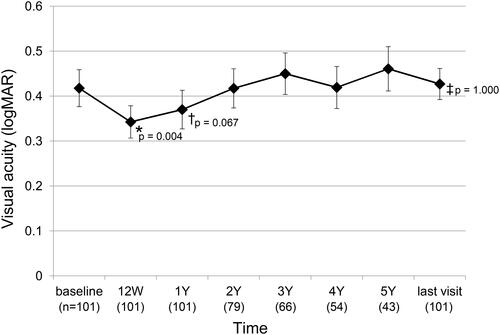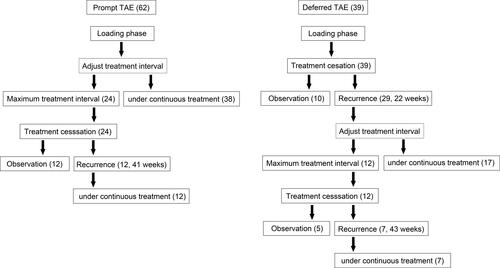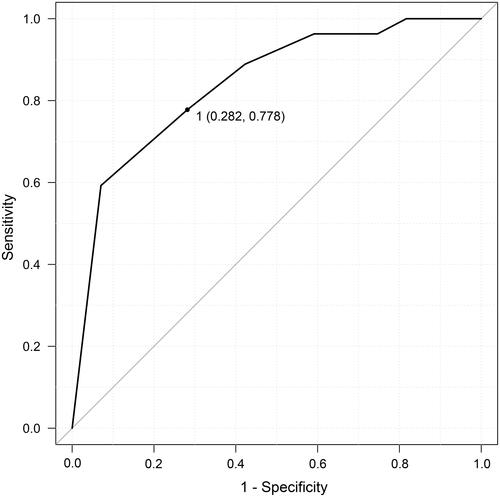Figures & data
Table 1 Baseline Demographic Data of the 101 Studied Patients
Table 2 Visual Outcome, Central Retinal Thickness, and Treatment Frequency in Different Disease Types
Figure 1 Temporal changes in the best-corrected visual acuity (BCVA). Compared with the baseline BCVA, the BCVA significantly improved at 12 weeks, but not at year 1 and the last visit. Error bars indicate standard errors. *p = 0.004, †p = 0.067, ‡p = 1.000.

Table 3 Multivariate Regression Analysis for Determinants That Could Affect the Estimated Annual Number of Injections
Figure 2 Summary of the treatment course using two treat-and-extend (TAE) regimens. The numbers of eyes are shown in parentheses. Regarding eyes with post-cessation recurrences, the median treatment-free periods between treatment cessation and recurrences are shown in parentheses next to the number of eyes. Among 62 eyes treated with the prompt TAE regimen, 24 (39.3%) eyes achieved treatment cessation. Among them, 12 (50.0%) eyes were treatment-free at the last visit, with a median treatment-free period of 53 weeks. Twelve (50.0%) eyes had recurrences after a median treatment-free period of 41 weeks. Among the 39 eyes treated with the deferred TAE regimen, 10 (25.6%) eyes lacked additional injections after the three loading injections until the last visit, with a median treatment-free period of 165 weeks. Twelve (30.7%) eyes reached treatment cessation after TAE following recurrence. Among them, 5 eyes were under treatment cessation at the last visit, with a median treatment-free period of 166 weeks.

Table 4 Comparison of Variables Between Eyes Under Continuous Treatment and Treatment Cessation
Table 5 Multivariate Logistic Regression Analysis of Factors Associated with Successful Treatment Cessation at the Last Visits and Successful Treatment Cessation During the Study Period
Figure 3 Receiver operating characteristic (ROC) curve for predicting successful treatment cessation at the last visits. ROC analysis showed that the area under the curve was 0.841. The curve was closest to the upper-left corner with a sensitivity and specificity of 0.718 and 0.778, respectively, when the cut-off value for the recurrence number was set to ≤1.

